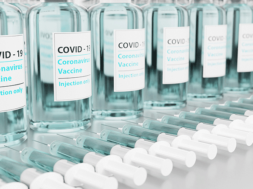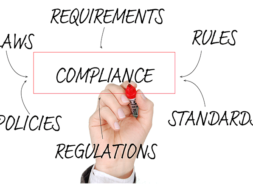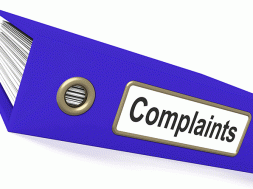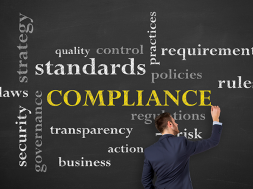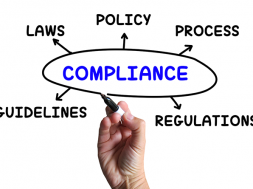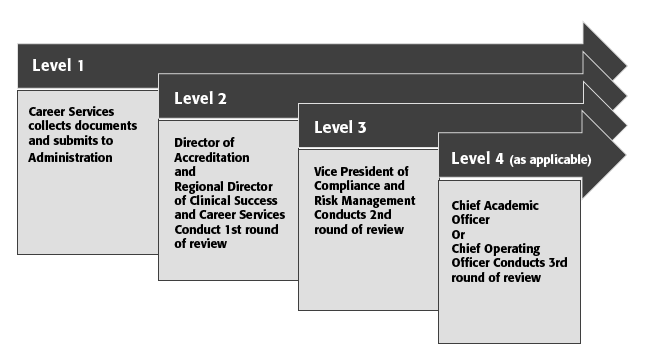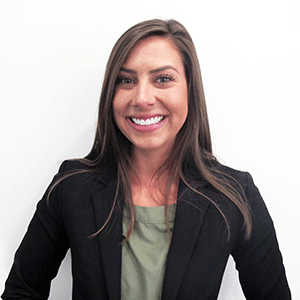
Graduate Placement Documentation – Best Practices to Ensure Compliant Documentation
By Kim Cook, Regional Director of Clinical & Career Success, American Career College and Lauren Irvine, Director of Accreditation and Licensing, American Career College
Career colleges’ long term viability depends on their placement documentation. Effective January 2019, the Accrediting Bureau of Health Education Schools (ABHES) created a new placement standard. ABHES removed the category entitled “related placement” and now requires all placed graduates to be in field placements, where the “majority of graduate’s job functions are related to skills and knowledge acquired through completion and training of the program.”
Given the new placement standard, how do you navigate the potentially muddy waters of back up documentation?
A good starting point is to identify if your placed graduate falls into one of these three categories:
- The graduate’s job title does not match the educational program name. An example may be a medical assistant graduate who obtains a job as a medical coder.
- A graduate is unavailable for placement, through one of the five ABHES defined categories.
- A graduate maintains the same job position throughout their educational program and upon graduation, confirmation of the promotion and new responsibilities is required.
If you find that your placed graduate falls into one of the three categories identified, what can be used as proof to substantiate your placement? A job description, email from the employer, graduate’s offer letter, military orders, enrollment agreements, death certificate, doctor’s note, arrest documentation or a graduate attestation are some examples that provide evidence to support a placement or unavailable categorization.
Obtaining corroborating placement documentation relies heavily on your Career Services (CS) department building a relationship with students throughout their educational journey, not at the end. Encourage your CS department to develop multiple checkpoints with students and graduates, beginning with classroom participation. Identifying job leads and interview preparation go without saying. Checking in on day one to confirm the graduate started their new job, on day 15 to verify they are still employed and an additional check in on day 35 or thereafter to verify the graduate is still working to meet state placement requirements (state specific requirements vary).
It is important to remember that if you are using electronic documentation collection, ensure you have an electronic signature policy to define acceptable records. Utilize the expertise of a third-party placement verification in addition to your own process, but not as a replacement. Back up documents may also be obtained through multiple collection methods including text, phone, email, survey, fax, third-party companies.
A best practice for reviewing placement documentation is to develop a regular process for review.
At American Career College, a multilevel review committee process has been implemented to evaluate placement documentation on a weekly basis.
During this review process, any graduates who fit into one of the three categories outlined as requiring additional back up documentation will be reviewed. It is also a best practice to review any potential job descriptions prior to placing graduates in the position. Examining O*NET SOC codes and the program’s learning outcomes or training objectives may be helpful in determining if the job duties meet the standards of a placement by the ABHES definition.
What are we looking for when reviewing the placement documentation? Are all ABHES requirements documented? Name of graduate, place of employment, job title, employer telephone number, employment and verification dates. Is there a minimum of 15 days between the graduate’s start date and the verification date? Are the documents legible? Were the majority of the job duties related to skills and knowledge acquired through the successful completion of the training program? Figure 1 illustrates the step by step procedure.
Figure 1: Placement Approval Process
Level 1 consists of the Career Services team collecting the placement documentation and submitting it to the Administration/Home Office for review. Level 2 consists of a first round of review by the Director of Accreditation and Regional Director of Clinical and Career Success. Both parties in Level 2 must be in agreement to approve the documentation, and then it is sent up to the Vice President of Compliance and Risk Management as Level 3. If both parties do not approve the placement at Level 2 then the placement is withdrawn until additional information is submitted. If the Vice President of Compliance and Risk Management is in agreement and approves the documentation, then the decision is final and communicated back to the Career Service team at the campus. If a decision is not unanimous between Level 2 and Level 3, proceed to Level 4. At Level 4 the placement is sent to the Chief Academic Officer or Chief Operating Officer for final review. Once Level 4 has made a decision on whether to approve or deny, the decision is final.
There are several advantages to having a multilevel committee review the documentation; multiple stakeholders reduce the individual bias of one person’s opinion or perspective. This process decreases the possibility of anything “falling through the cracks.” The team members are aware that all placement records will be reviewed by senior staff. This process ensures the organization is ready at all times and prepared for an accreditation visit.
Another benefit to reviewing the placement documentation regularly is that when the ABHES annual report requires back up documentation, your organization is not scrambling to find missing documentation.
The committee meets on a regular basis, thereby ensuring that any additional clarification documents are requested in a timely manner. We all know that time is not a friend to career services.
The longer you wait, the more difficult it is to obtain corroborating records. Consider that an accreditation evaluator that comes to your campus for an on-site visit may not be familiar with local hiring trends. Using this committee process, as multiple stakeholders approve the documentation, the higher the probability that the on-site accreditation evaluator will agree with the assessment.
Every placement is examined for the responsibilities, qualifications, education, experience required, and most importantly, the skills being used. A few common errors to look for:
- Names don’t match (e.g., graduate got married and the name changed);
- Employer documentation is different from graduate documentation;
- Doctor’s note is unclear;
- Company name on verification is different due to ownership by a subsidiary, umbrella parent company, or national corporation;
- College term has not yet begun for unavailable graduates; and
- Same employer disclosure has not been completed at least 15 days after the promotion date.
Consider following the golden rules of compliance when reviewing records for accreditation requirements. First, when in doubt, ask for more documentation. If it is not stated in black and white, request additional details. Second, can you defend this placement in an audit? Lastly, strive to exceed minimum benchmarks to allow room for error.
Whether we like it or not, our industry is driven by numbers. How is your success measured? Not by the number of in-field placements you report, not by deducting your unavailable for placement, not by counting your verifications. The metric that truly matters is how many lives you changed.
“If you think compliance is expensive – try non-compliance.” – Former U.S. Deputy Attorney General Paul McNutty
“You can get compliance as a by-product of just doing your job right in the first place.” – Colin Clark
KIM COOK spent the last 25 years leading teams in career placement, education and healthcare management. With an Interdisciplinary Master’s in healthcare, educational leadership and writing, Kim is a high energy optimist, dynamic speaker, True Colors Facilitator and Certified Professional Resume Writer. Her current role is Regional Director of Clinical and Career Success and she conducts training seminars in leadership, customer service, compliance, communication and sales training. She co-authored “The Sage Workbook” and leads interactive motivation seminars entitled, “What are you creating?” Kim inspires, motivates and provokes life changing action by demonstrating how to turn obstacles into opportunities, changing the world, one smile at a time.
Contact Information: Kim Cook // Regional Director of Clinical & Career Success // American Career College // 562-400-3026 // kcook@americancareercollege.edu // https://www.linkedin.com/in/kim-mcgregor-cook-05632557/ // Whatareyoucreating.com // Facebook // Twitter
LAUREN IRVINE is the Director of Accreditation and Licensing for American Career College. With over seven years of accreditation and compliance experience, Lauren manages correspondence between the College and all accreditation and state agencies, annual reporting, internal mock audits, and the accreditation on-site visit process. Lauren serves on the ABHES Preliminary Review Committee (PRC) and as an ABHES Team Leader evaluator.
Contact Information: Lauren Irvine // Director, Accreditation and Licensing // American Career College // 760-413-2037 // lirvine@americancareercollege.edu // https://www.linkedin.com/in/lauren-irvine-72b41676/

